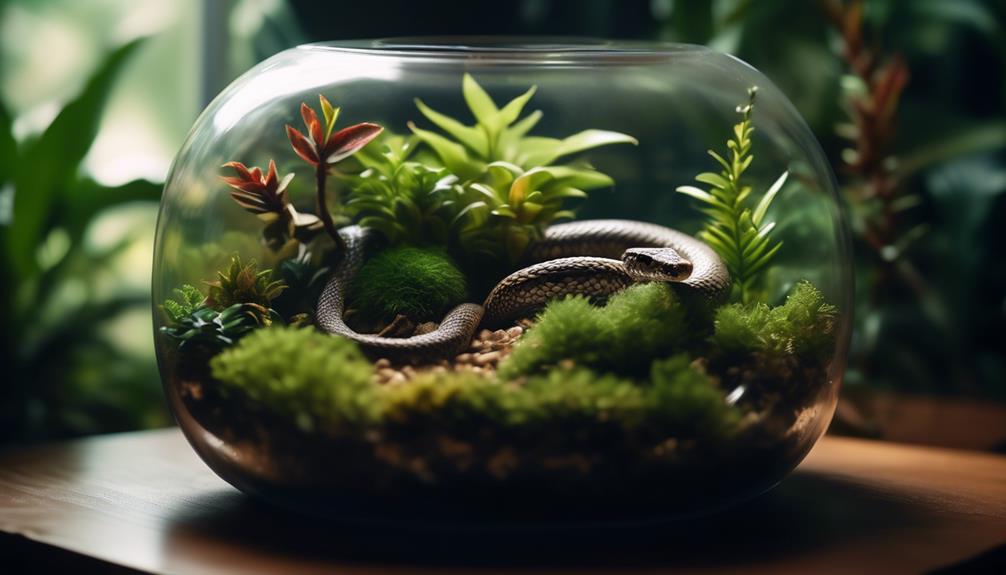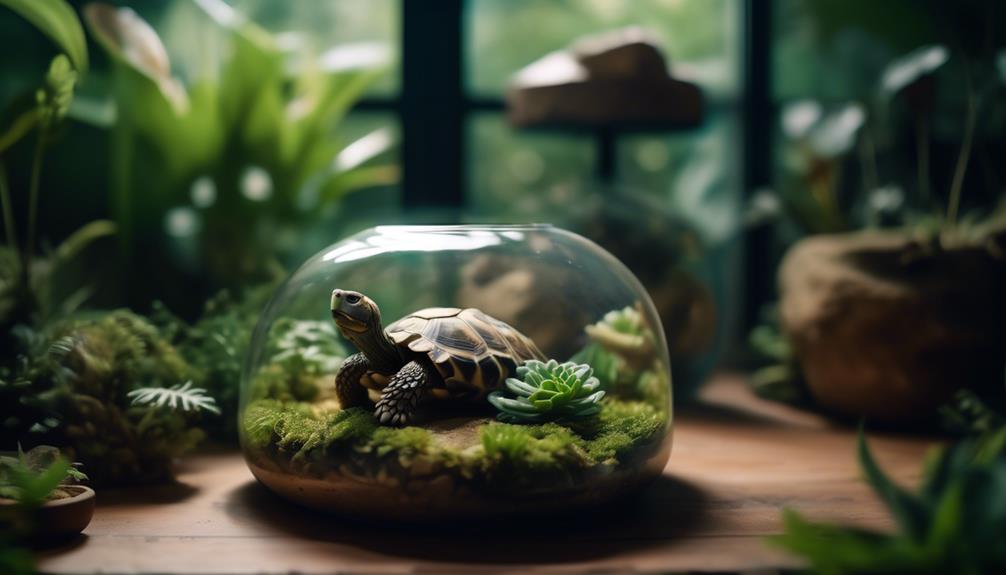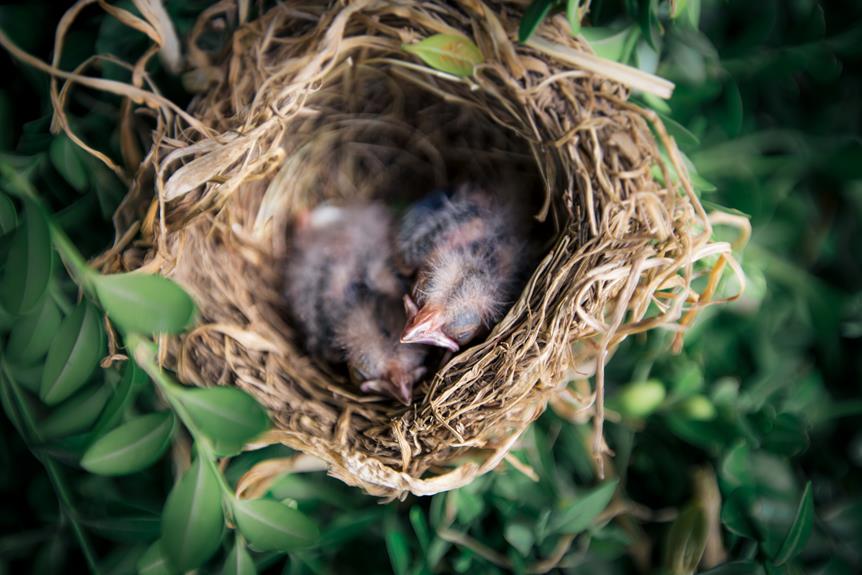Did you know that Viper Boas are known for their unique heat-sensing ability, allowing them to detect the body heat of their prey? Fascinating, right? If you're a Viper Boa owner or considering becoming one, you're in the right place.
In this comprehensive guide, we will explore the essential aspects of Viper Boa care, from creating the perfect habitat to ensuring a balanced diet and preventing common health issues. But that's not all. We'll also share some expert tips and tricks that will help you become a confident and responsible Viper Boa owner.
So, let's embark on this exciting journey together and uncover the secrets to mastering the art of Viper Boa care.
Key Takeaways
- Viper boas require a spacious enclosure that allows them to stretch out, thermoregulate, and explore. Larger enclosures are beneficial for their well-being.
- Access to UVB lighting is necessary for optimal health and well-being. Viper boas do best with low-strength UVB bulbs placed close to the heat lamp.
- Viper boas need a humid and moist environment, with average ambient humidity levels between 50-80%. Providing a humid hide and misting the enclosure helps maintain humidity levels.
- Viper boas require a thick layer of moisture-retentive substrate, such as Zoo Med Eco Earth or Exo Terra Plantation Soil. Adding clean leaf litter on top helps with humidity and provides cover. The substrate should be replaced every 3-4 months.
Housing Requirements for Viper Boas
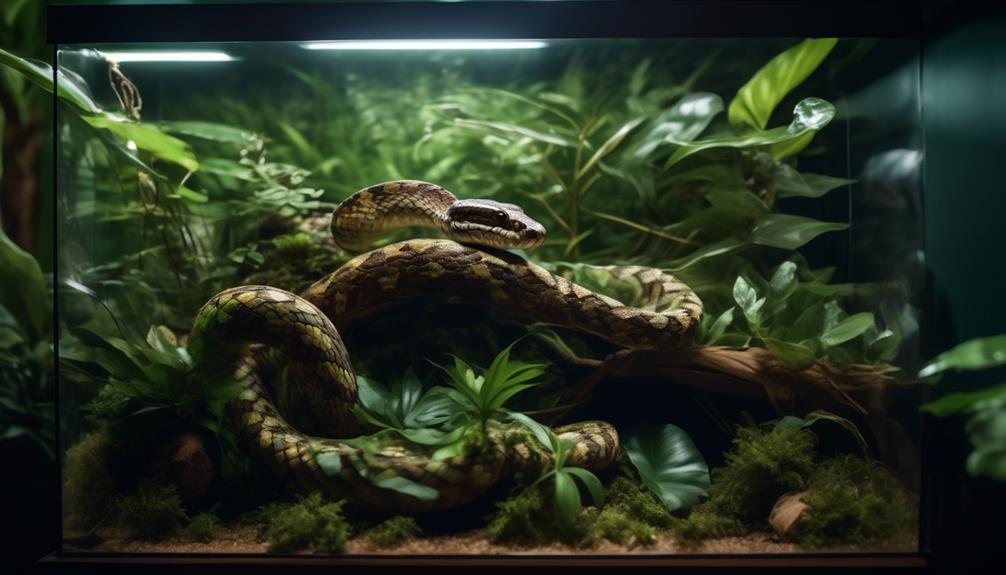
When considering the housing requirements for Viper Boas, it's essential to provide an enclosure that meets their specific needs for space, privacy, and exploration. The Viper boa enclosure design should be at least 36 inches in length, 18 inches in width, and 16 inches in height.
It's recommended to use a front-opening enclosure with opaque sides to provide a sense of security and privacy for the snake. Cohabitation isn't recommended as Viper boas aren't social animals.
The enclosure should allow the snake to stretch out, thermoregulate, and explore its surroundings. Larger enclosures are beneficial and fully utilized by the snake, providing ample room for movement and enrichment.
The Viper boa habitat setup should prioritize the snake's comfort and natural behaviors, providing a space where it can thrive.
UVB Lighting and Basking Temperatures
To ensure optimal health and well-being for Viper Boas, it's crucial to provide them with appropriate UVB lighting and maintain the correct basking temperatures in their enclosure. Proper lighting and temperature regulation are essential for the overall health and vitality of these snakes. Here are some key points to consider:
- UVB Lighting: Viper boas require access to low-strength UVB lighting to provide them with essential vitamin D, stimulate appetite and activity, and promote overall health. Recommended UVB bulbs include Zoo Med Reptisun T5 HO 5.0 and Arcadia Forest 6%. The UVB bulb should be housed in a reflective fixture and placed close to the heat lamp.
- Basking Temperatures: The basking surface temperature should be maintained between 86-90°F, while the cool side temperature should be between 78-82°F. It's important to provide a cool area in the enclosure to allow the snake to thermoregulate effectively. Heat can be provided with a low-wattage halogen heat bulb.
Humidity Levels for Viper Boas
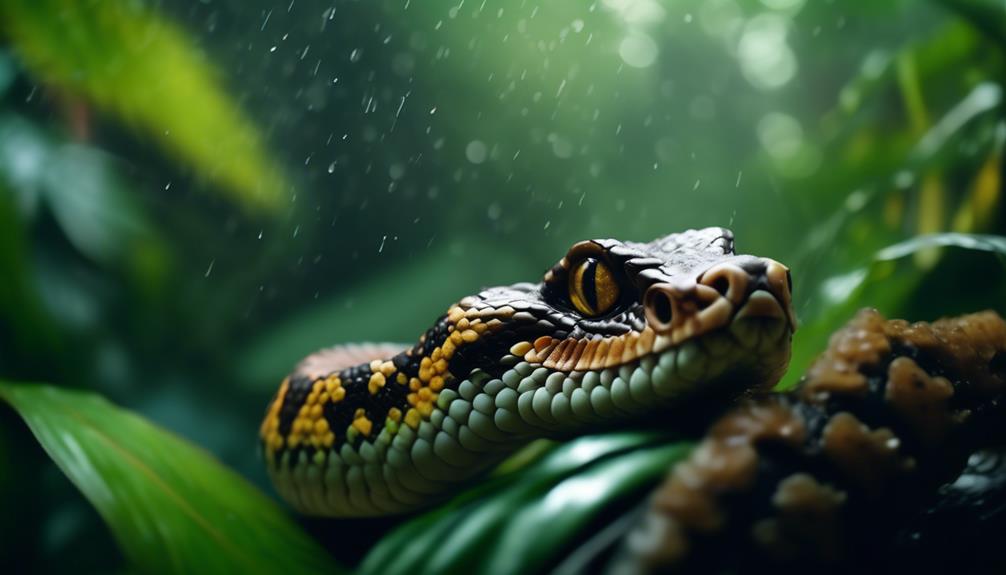
Maintaining appropriate humidity levels is crucial for the health and well-being of Viper Boas. These snakes require a humid and moist environment, with average ambient humidity levels ranging between 50-80%. To ensure that the humidity levels are within the optimal range, it is important to monitor and maintain them regularly.
To assist with humidity monitoring, consider using a hygrometer, which measures the moisture content in the air. This will help you determine if adjustments need to be made to increase or decrease humidity levels. Additionally, here are some key tips for maintaining humidity levels in the viper boa enclosure:
| Humidity Tips | Description |
|---|---|
| Provide a humid hide | Line a hide with moistened sphagnum moss to create a microclimate with higher humidity. |
| Regular misting | Mist the enclosure twice a day to help maintain humidity levels. |
| Extra-large water bowl | Provide a water bowl that is large enough for the snake to soak in, but not deeper than 6 inches. |
Substrate for Viper Boas
Moving on to the care of Viper Boas, let's now discuss the crucial aspect of selecting the appropriate substrate for these snakes. Choosing the right substrate is essential for maintaining the proper humidity levels and providing a comfortable environment for your Viper Boa. Here are some of the best substrate options to consider:
- Zoo Med Eco Earth: This coconut fiber substrate is highly moisture-retentive and promotes natural burrowing behavior.
- Zoo Med ReptiSoil: This blend of topsoil and coconut fiber is great for maintaining humidity and providing a naturalistic look.
- Exo Terra Plantation Soil: Made from compressed coconut husk, this substrate is ideal for promoting humidity and root growth for live plants.
- Zilla Jungle Mix: This blend of peat moss, fir bark, and coconut husk retains moisture well and creates a naturalistic habitat.
To ensure the best substrate maintenance, remember these tips:
- Keep the substrate at least 3 inches deep to allow for burrowing and moisture retention.
- Replace the substrate every 3-4 months to prevent the buildup of waste and bacteria.
- Remove waste and contaminated substrate daily to maintain cleanliness.
- Add clean leaf litter on top of the substrate to enhance humidity and provide hiding spots for your Viper Boa.
Feeding, Handling, and Common Health Issues
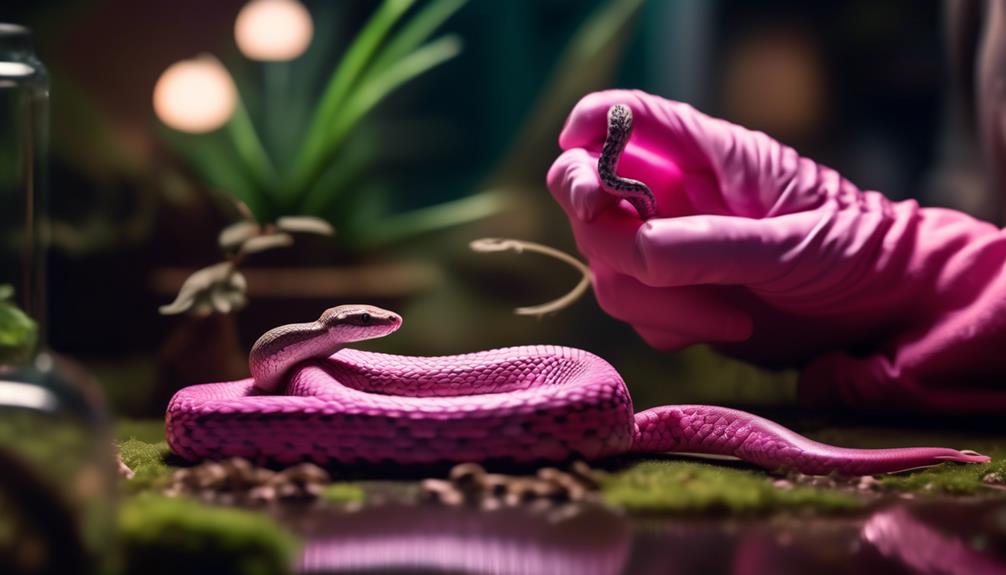
Feeding Viper Boas appropriately sized rodents is essential for their nutritional needs and overall health. When it comes to feeding techniques, it's recommended to offer pre-killed prey to avoid injuries to both the snake and the prey. Juvenile Viper Boas should be fed every 5-7 days, while adults can be fed every 10-14 days. It's important to provide a balanced diet with variety, including mice, rats, and chicks. Monitoring the snake's weight is crucial to ensure proper growth and adjust feeding schedules accordingly.
Handling safety is another important aspect of Viper Boa care. While it's best to limit handling to minimize stress, when necessary, proper handling techniques should be utilized to prevent bites. Give the snake time to acclimate to its new environment before attempting any handling. Observe the snake's behavior for signs of discomfort or aggression and avoid interaction during shedding periods.
Common health issues to watch out for include respiratory infections, which can manifest as wheezing or the presence of mucus in the snake's respiratory system. Maintaining a clean and hygienic enclosure is crucial to prevent infections. Regularly check for external parasites such as mites and ticks, and ensure proper shedding by maintaining appropriate humidity levels. Finally, scheduling regular veterinary check-ups will help monitor the snake's overall health and address any potential issues promptly.
Frequently Asked Questions
Can Viper Boas Be Housed With Other Snake Species?
No, viper boas cannot be housed with other snake species. They are not social animals and prefer to live alone. Additionally, they have specific housing requirements and feeding difficulties that make cohabitation unsuitable.
How Often Should the UVB Bulb Be Replaced?
When should we replace the UVB bulb? UVB bulbs typically last around 6-12 months, but it's best to replace them every 6 months to ensure optimal performance. Regular replacement ensures your viper boa receives adequate UVB lighting for its health and well-being.
What Should I Do if My Viper Boa Refuses to Eat?
If our viper boa refuses to eat, we would first assess its habitat conditions, stress levels, and overall health. Implementing proper handling techniques and monitoring for common health issues such as respiratory infections are crucial steps in resolving this issue.
How Do I Prevent My Viper Boa From Escaping Its Enclosure?
To prevent escapes, ensure a secure viper boa enclosure. Use a front-opening enclosure with secure locks. Check for gaps or weak spots. Use heavy-duty materials. Monitor enclosure regularly for any signs of wear or damage.
What Should I Do if My Viper Boa Develops a Respiratory Infection?
If your viper boa develops a respiratory infection, it's important to seek treatment options from a veterinarian. Symptoms and signs may include wheezing and mucus. Prompt intervention and a clean, hygienic enclosure are crucial for their recovery.
Conclusion
In conclusion, mastering the art of Viper Boa care requires a thorough understanding of their housing requirements, UVB lighting and basking temperatures, humidity levels, substrate choices, as well as proper feeding, handling, and identification of common health issues.
By providing the ideal habitat and following the guidelines outlined in this guide, you can ensure the health and well-being of your Viper Boa.
With this knowledge and responsibility, you can confidently embark on your journey as a Viper Boa owner.
